Sidestepping angst
With 50-pound salt blocks and a power washer, Mollie McKinley explores the messy business of transformation
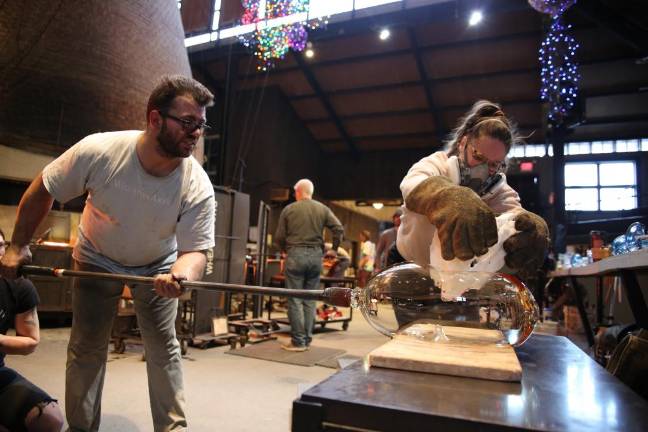
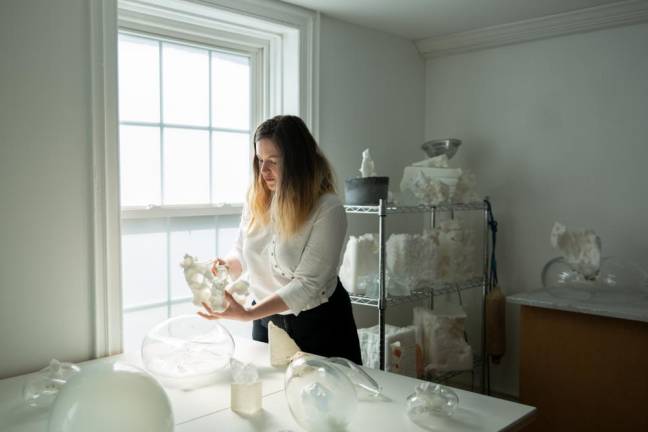
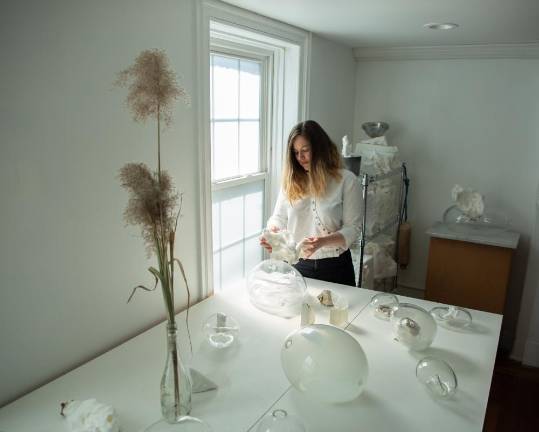
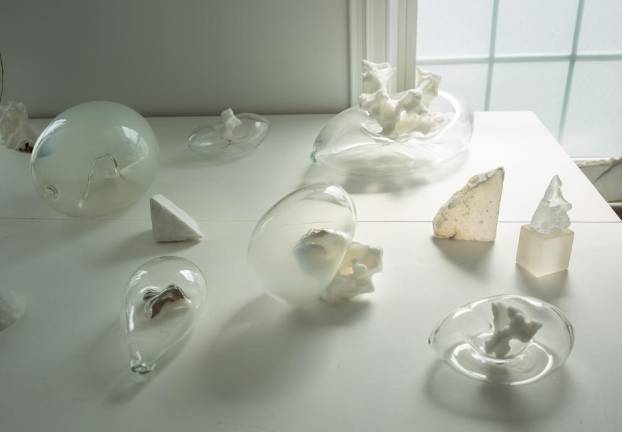
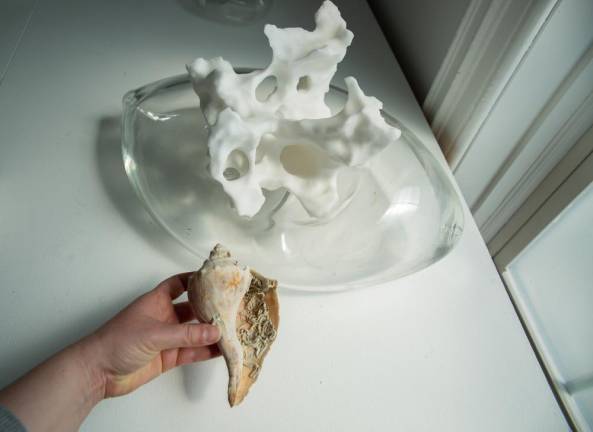
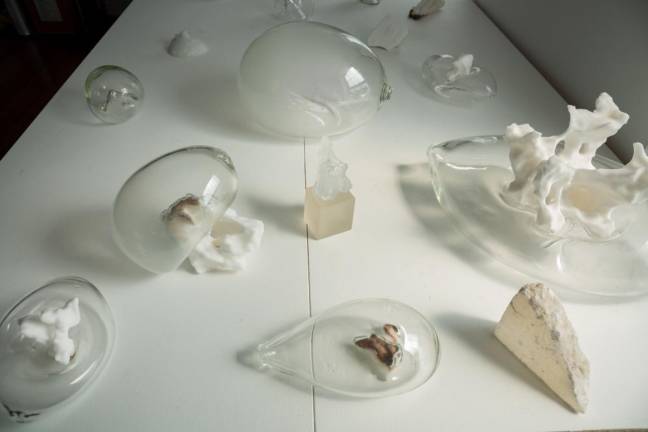
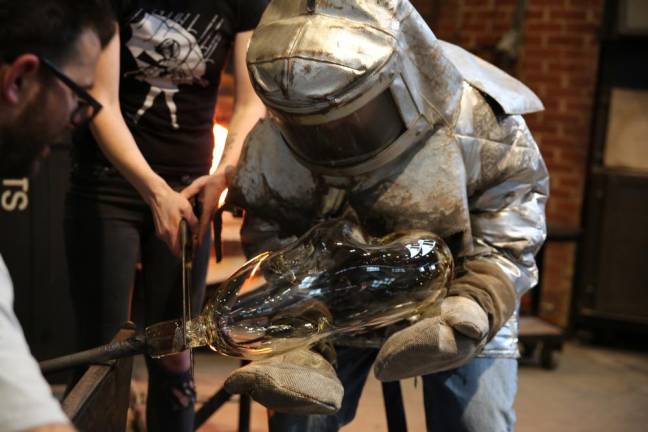
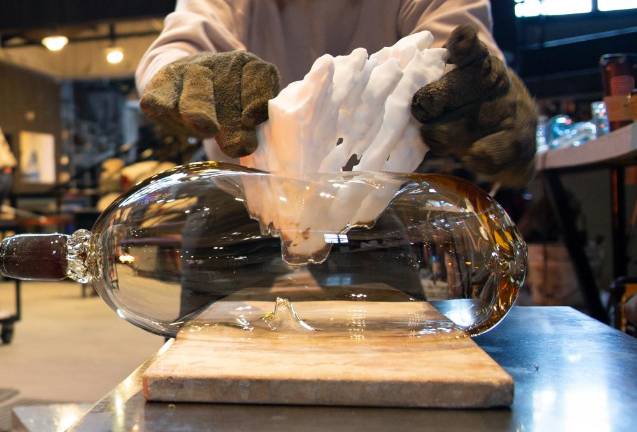
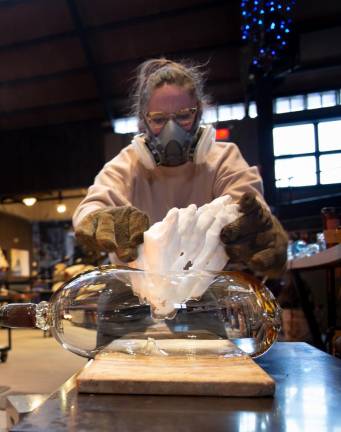
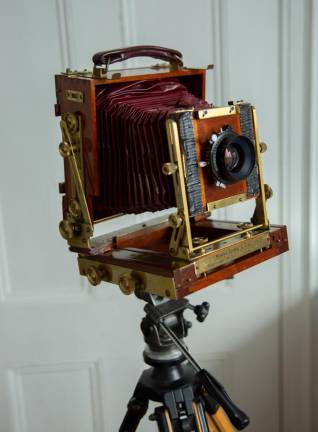
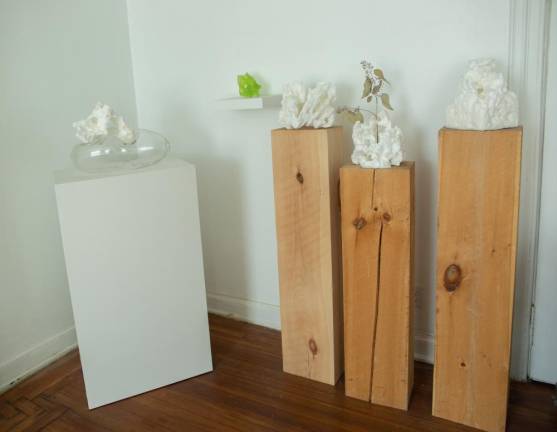
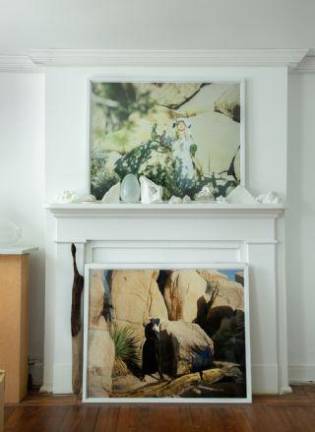
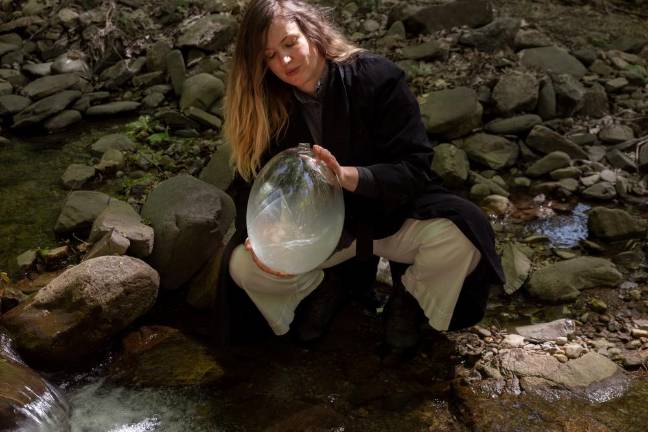
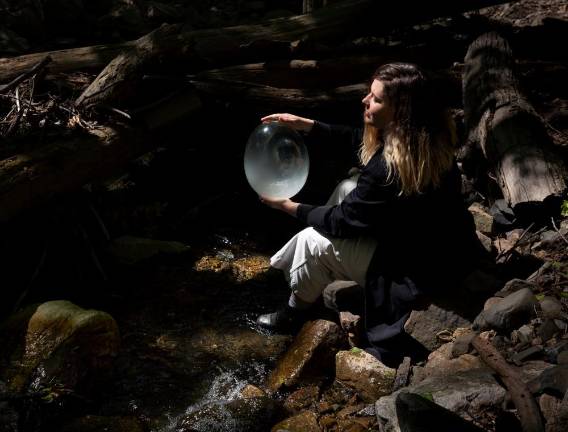
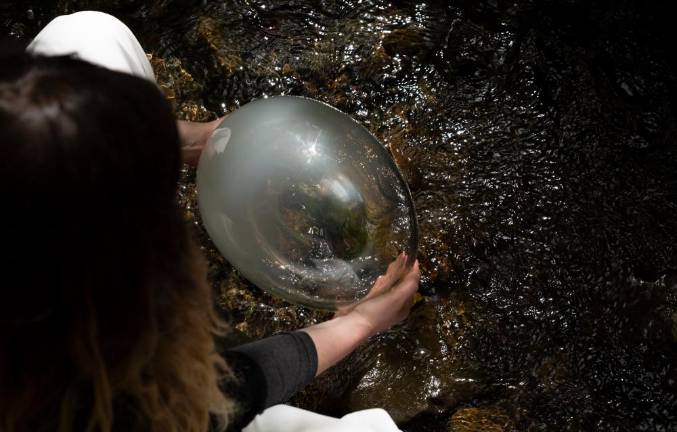
A series of clear glass pillows enveloping delicate salt erosions are arranged on a table in Mollie McKinley’s home studio. These are some of her sculptures for Salt Cradle, the show that would have debuted at Mana Contemporary in Jersey City this spring.
She can sculpt the salt in her backyard – a messy and fragile business. And luckily, her historic house in downtown Newburgh houses a small studio. However, these “small organic monuments to softness and the transformation of matter,” as she describes them, require a team of three additional assistants to complete. The team works in close proximity to manipulate the molten blown glass as McKinley unites it with the salt. That’s definitely not happening now.
Like everyone else, McKinley found her life and creative practice disrupted, her headspace occupied by a scary uncertainty. “The first few weeks were really a freak-out for me,” admits McKinley, who uses sculpture, performance and photography to express her artistic vision. “But as I settled into it, I felt like I could access a different, quieter part of myself for the first time in a while.”
Normally McKinley commutes to the city to meet with artist friends, work on projects with them and go to show openings. Since the pandemic they’ve been meeting up weekly online to draw together and talk. She’s using the time to research landscape art, work on mockups for future installations and create content for at-home learning exercises for Dia Beacon. Most of all, she’s leaning into her writing practice.
No matter what, as spring arrives in the lower Hudson Valley, McKinley takes her daily meditative walks in the woods or along the Hudson River. She listens to the cacophony of birdsong, disturbs a snake about to eat a frog, and surrenders to the flow around her, silencing her inner critic. “Walking in nature, that’s my practice,” she explains. “The landscape is my true studio.”
Although she is only in her thirties, McKinley has dealt with her share of trauma and loss, and it has shaped her artistic journey and in its way, has also prepared her to deal with the pandemic.
From an early age, McKinley has valued solitude, learning to use those quiet times for introspection and transformation. In a recent piece of writing, The Unceremony, McKinley defines home. “My parents moved seven times before I was 14, but Cape Cod tethered me to an ancestry and a belonging, the only sense of continuity in my life... Sandwich is the lens through which I make sense of myself.”
McKinley spent summers with her grandmother, living in a modest and austere house from the 1700s, without modern appliances or TV, connecting her to the ghosts of her Puritan ancestors. Much of McKinley’s time was spent outdoors, exploring the untamed, transitional landscape of dunes and marsh, wading through thigh-deep mud, hunting for “treasure” in the form of blobs of iridescent glass slag, discarded in the 1800s from the Boston and Sandwich Glass Company. “The quality of light on Cape Cod added to that romantic, cinematic experience,” she says. “I didn’t have a language for that as a child, but I always felt I was the star of my own weird, lonely gothic drama.”
Since she was a teen, she has expressed herself through theater and performance, watching countless hours of kitschy supernatural films from the 1970s for inspiration. She also has an inquiring mind that seeks to make sense of her experiences through intellectual and philosophical exploration.
Her freshman year of college, studying poetry, philosophy and painting at the University of Colorado at Boulder, McKinley’s father died after a long illness. In her grief, she found she couldn’t paint anymore. She signed up for a photography class. “I think on a visceral and subconscious level photography really spoke to me at the time about death – this entombment of light and shadow.” She dropped out of school, but a chance encounter led her to Bard College in the Hudson Valley where she transferred to study film and photography, specifically the use of large format field cameras, ideal for capturing landscapes with high quality prints.
In the film department, McKinley was given full poetic license to make experimental 16mm films. The photography program was much stricter, with intense rules. McKinley thrived under the limitations of the complicated technical process of using large format cameras. “I fell in love with the way staged photography connected me to the poetic and to theater. It was so cinematic, a way for me to make ‘film’ with sets and actors.”
When McKinley moved to New York City after college, she embraced the quintessential artist’s life. In her twenties she lived and worked in rough, warehouse spaces in Brooklyn, exploring different mediums, taking part in experimental pedagogical workshops and collaborating with fellow artists. Her friends became subjects for her storytelling performance videos, and cinematic photo tableaus, set in site specific landscapes. But there was something about photography that wasn’t expressing all that she needed to articulate.
A moment of radical change came when McKinley was accepted to a residency program in the Catskills with the School of Making Thinking, an artists’ collective. Sharing philosophical ideas through playful performance, the group set out to explore the idea of liminality – the uncomfortable, in-between stage during a rite of passage, a waiting space ripe for transformation. “That completely encapsulated everything I’d ever been interested in and packaged it in an engaging, embodied questioning,” says McKinley. “It shifted my practice and how I move through the world.”
McKinley is fascinated with the theatrics of ritual derived from her love of supernatural 70s movies – the operatic style and use of kitschy objects – as a playful way to approach existential questions, sidestepping angst. Now she has a language to explore the deeper intellectual ideas behind them and investigate the social baggage we bring to the idea of ritual, opening up a more interdisciplinary approach to her work.
Exploring new materials, McKinley began playing around with 50-pound salt blocks bought from Tractor Supply, originally intended as a nutritional supplement for livestock. “Salt is alchemical, representing the body and ritual in mystic traditions,” she explains. Using a power washer to carve into the salt, she produced delicate, translucent erosions. While others were drawn to the sculptural pieces, McKinley knew she didn’t as yet have a place for them in her narrative.
In the midst of this investigation, she got sick and was hospitalized for a long time. “Catastrophic illness is the most in-between place,” says McKinley. “You’re hanging off the cliff. It’s like being invited into a transformation.” She knew she had to respond to it in her work.
Even before she was fully recovered, McKinley began a new series of performance rituals staged for photographs. Only now, instead of working with actors and sets that she had to corral and direct, she pared it down to herself, a few props, and her field camera. She was seeking a new sense of intimacy in her images, redefining the space where her body meets the world.
McKinley describes her first trip to work in the California high desert around Joshua Tree as a kind of pilgrimage. Long interested in geologic time, the austere landscape – granite rocks sculpted over eons by wind and erosion – had the same mystic pull for her as Cape Cod. She wanted to experience the dialogue between her body and that landscape in front of the camera.
With the help of her partner, Noah Sokoloff, they took the arduous trip, carrying her bulky Wisner Technical Field camera. Her props are not the kinds of things you normally associate with ritual. They are objects that appeal to her, such as pineapples, buoys and plastic bags – the antithesis of sacred objects. This new visual language confronts the weight of culture with levity. In her blonde wig and bathrobe, McKinley plays the Priestess, a mystic vagabond who holds the power to transform and possibly answer some of those deep existential questions of hierarchy, time and mortality.
When she first met Sokoloff, a glass blower and painter, McKinley was thinking about making castings from her salt sculptures, but hadn’t figured out what material to use. Sokoloff invited her to watch him work, and she immediately signed up to take classes at Urban Glass in Brooklyn. The glass makers she befriended told her the casting process for the delicate salt objects would be nearly impossible. McKinley persisted, renting studio space, learning from others, and gradually refining the complicated mold-making process.
She was excited to be accepted to a glass casting residency at Wheaton Arts in Millville, NJ. Now she could produce finished pieces. From her studio, she watched glass blowers working all around her as she toiled away at casting replicas of her salt sculptures. Their process seemed improvisational and fluid in comparison. With only two days left until the end of the residency, physically exhausted, her mind and body led her to the perfect resting place for her salt sculptures: McKinley knew she had to ask the glass blowers to help her make a series of blown glass pillows.
She was exhilarated with the result. “The work is about the body, caring for the body, approaching the body with softness. It felt like I had found this perfect articulation of what the salt was supposed to be for all along. The work felt really clear, and yet really experimental, and had years of experience and philosophical ideas behind it – personal and intellectual and messy and clean.”
She nailed it – and now it’s onto the next. Although the exhibition for Salt Cradle is postponed, McKinley has no interest in finding a successful formula and repeating it over and over.
“Resilience and transformation are built into the core concepts of my practice,” says McKinley, who is headed upstate to pursue her MFA at Alfred University in the fall. “So no matter what happens over the next few years or how that shifts my work to come, I feel excited about how my practice will nourish me, and I can contribute to society in my role as an artist.” She is ready to move on, perhaps explore working with stone.